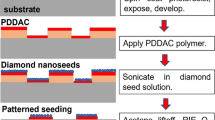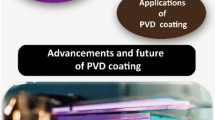Abstract
A comparative study of DC, RF and VHF excitation for the plasma enhanced chemical vapor deposition (PECVD) of intrinsic layers of a-Si:H is presented, with special emphasis on the effects of hydrogen dilution. Growth rates at comparable plasma power, for substrate temperatures between 100°C and 300°C and for various H2 dilution ratios are presented, along with optical bandgap, H content, and electronic transport properties in the light-soaked state.
H2 strongly reduces the growth rate for all techniques. The growth rate for the highest H2 dilution ratio is approximately four times higher for VHF than for DC or RF excitation. In all three cases increasing the substrate temperature reduces the optical gap and the H content CH. Raising the substrate temperature slightly enhances the stability of undiluted films. H2 dilution increases the optical gap for all three techniques. The H content of RF- and VHF-deposited samples increases with increasing H2 dilution ratio, while in DC deposition it produces an initial drop of the H content, followed by an increase.
In all three cases, H2 dilution improves the electronic transport properties of the material by roughly a factor of two. The gain in stability is most pronounced for relatively small dilution; in the case of DC deposition, too strong a dilution even has an adverse effect on stability.
Similar content being viewed by others
References
S. Guha, K.L. Narasimhan and S.M. Pietruszko, J. Appl. Phys. 52 (1981) 859.
S. Guha, Proc. 25th IEEE PVSC (1996) 1017.
B. Rech, S. Wieder, F. Siebke, C. Beneking, H. Wagner, MRS Symp. Proc. 420 (1996) 33.
R. Platz, D. Fischer, S. Dubail and A. Shah, Solar Energy Materials and Solar Cells 46 (1997) 157.
L. Yang, M. Bennett, L. Chen, K. Jansen, J. Kessler, Y. Li, J. Newtown, K. Rajan, F. Willing, R. Arya, D. Carlson, MRS Symp. Proc. 420 (1996) 839.
C. Hof, Y. Ziegler, R. Platz, N. Wyrsch and A. Shah, Proc. ICAMS-7 Budapest 1997, in print.
N. Beck, N. Wyrsch, C. Hof and A. Shah, J. Appl. Phys. 79 (1996) 9361.
T.I. Kamins, Polycrystalline silicon for integrated circuit applications, Kluwer Academic Publishers1988, p.68.
M. Bennett, K. Rajan, K. Kritikson, Proc. 23rd IEEE PVSC (1993) 845.
R. Platz, J. Meier, D. Fischer, S. Dubail, A. Shah, MRS Symp. Proc. 467 (1997) 699.
R. Platz, C. Hof, D. Fischer, J. Meier, A. Shah, Solar Energy Materials and Solar Cells, in print.
Acknowledgement
R. Platz thanks the Arthur u. Aenne Feindt Stiftung, Hamburg (Germany), the Fondation Charles-Edouard Guillaume, Bienne (Switzerland), and the Electric Power Research Institute for providing support for his stay at Princeton University. The authors thank S. Dubail for his technical assistance, as well as C. Beneking and F. Siebke for helpful discussions.
Author information
Authors and Affiliations
Rights and permissions
About this article
Cite this article
Platz, R., Hof, C., Wieder, S. et al. Comparison of VHF, RF and Dc Plasma Excitation for a-Si:H Deposition with Hydrogen Dilution. MRS Online Proceedings Library 507, 565–570 (1998). https://doi.org/10.1557/PROC-507-565
Published:
Issue Date:
DOI: https://doi.org/10.1557/PROC-507-565




